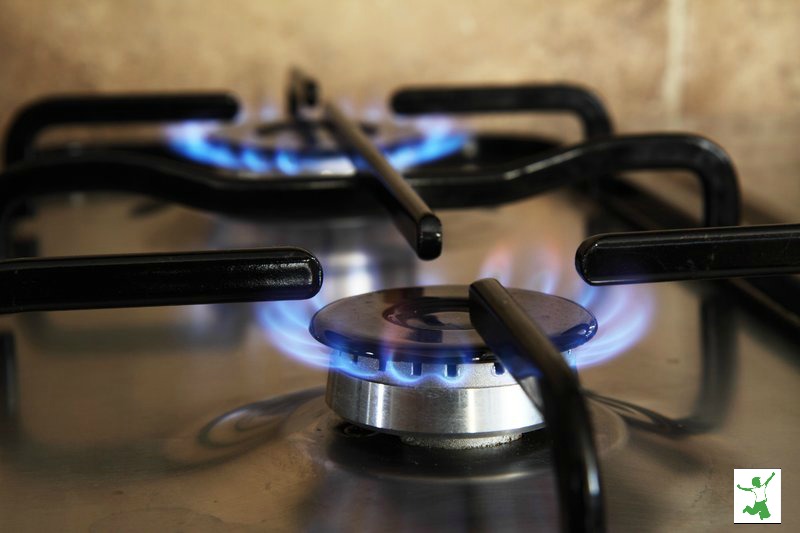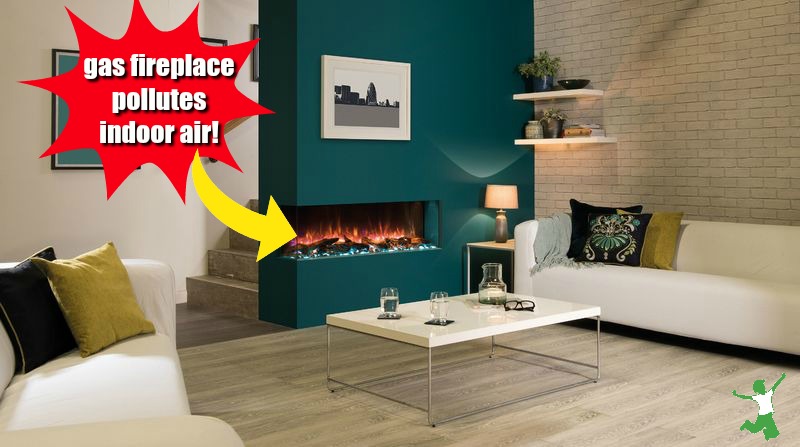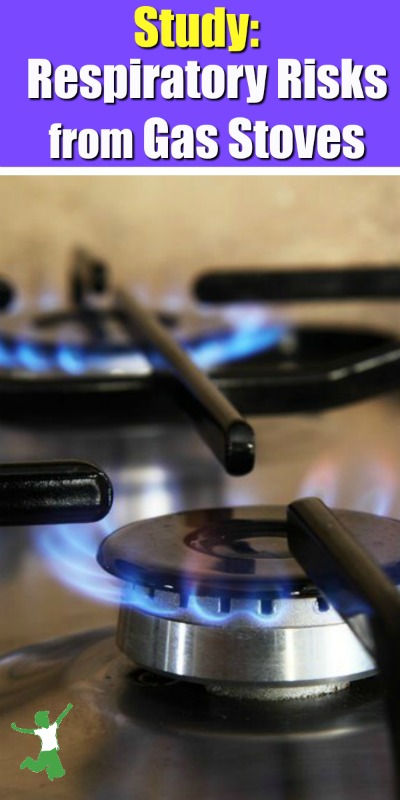
The measurable indoor pollutants generated by gas cooktops and ovens are 50-400 percent higher than homes without these types of appliances according to scientists. These emissions occur even when the stove is not in use. How to stay safe if you have children or a pre-existing respiratory condition.
I’ve written before about the EMF risks from induction stoves and why it is a better choice to use a basic (and cheaper) electric stove instead.
But what about gas stoves? These types of appliances have been in widespread use in Europe and the United States since early in the last century. Hence, most people consider them safe due to longevity alone.
But, is this really true?
Some new studies of indoor air pollution triggered by gas stove use give reason for a rethinking of gas-based appliances.
Homes with Gas Stoves Have Significantly Dirtier Indoor Air
According to a May 2020 review by the Rocky Mountain Institute, homes that use gas stoves have indoor air that is 2-5 times dirtier than outdoors.
Shockingly, this new review actually brings together decades of scientific research demonstrating that toxic pollutants are released when gas stoves are in use. These emissions absolutely have a negative impact on human health. (1)
In other words, this information has been known for over 20 years!
However, the research is only just now getting attention due to the realization that respiratory health and clean air are crucial to avoiding/surviving exposure to COVID-19.
And, with people spending more time and cooking more meals at home, the risks from gas stoves are greater than ever.
The lead author of the study, Brady Seals, writes that:
As a global pandemic shines a new light on health, air pollution, and the disproportionate impacts on vulnerable populations, it exposes the need to protect the public from risks both outside and inside the home. (2)
Types of Pollutants
There are three types of pollutants released by gas stoves.
- Nitrogen dioxide (NO2)
- Carbon monoxide
- Particle pollution
Exposure is particularly devastating for children and those living in smaller or older homes with less square footage and/or poorer ventilation.
Let’s take a look at some of the impacts of these pollutants on health.
Health Impacts of Gas Stoves
Nitrogen dioxide, the primary gas stove pollutant produced both on the cooktop and oven has the potential to trigger the following health effects, particularly in children: (3)
- Increased risk of childhood asthma (both current and lifetime)
- Aggravated respiratory symptoms (wheezing, coughing, chest tightness, difficulty breathing)
- Irritated airways
- IQ learning deficits
- Increased susceptibility to lung infections
- Deleted tissue antioxidant defenses (which protect the respiratory tract)
- Changed lung function
- Cardiovascular effects
- Increased susceptibility to allergens
There are three reasons why children are more susceptible to air pollution from gas stoves than adults.
First, children have higher rates of breathing and are generally much more physically active.
Secondly, their respiratory and immune systems are still developing.
Third, their bodies are smaller. Hence, children have a higher lung surface to body weight ratio than adults. (4)
Measured Emissions from Gas Cooktops and Ovens
The outdoor standards for NO2 emissions exposure are 100 parts per billion (ppb) for the United States (EPA) and 60 ppb for Canada.
Let me repeat that … these are the levels for outdoors.
Here are the indoor measured NO2 emissions levels when a gas stove is performing the following functions: (5)
- Baking cake in the oven (230 ppb)
- Roasting meat in the oven (296 ppb)
- Frying bacon on the stovetop (104 ppb)
- Boiling water (184 ppb)
Here’s the most disturbing piece of information. Even when a gas cooktop or oven is not cooking anything, it is producing NO2 emissions according to the study! (6)
- Gas cooktop (no food): 82-300 ppb
- Gas oven (no food): 130-546 ppb
Analysis reveals that gas stoves continue to pollute indoor air at levels significantly above safety guidelines even when otherwise not in use.
The author of the study puts it this way:
Homes with gas stoves can have nitrogen dioxide concentrations that are 50–400 percent higher than homes with electric stoves. The US Environmental Protection Agency (EPA) recently strengthened its assessment of nitrogen dioxide, finding a causal relationship between short term exposures and respiratory effects. (7)
Gas Fireplaces a Risk Too!
Note that anything in your home that uses gas is going to pose a similar risk to your indoor air.
For example, the popular gas-driven indoor fireplaces would add toxic pollutants to indoor air as well.

Go Electric for Cooking or At Least Do This
With induction stoves a source of electromagnetic toxicity and gas stoves conclusively proven to pollute indoor air even when not in use, you really need to make plans to go electric to be safe.
This is especially the case if you have young children or someone in the household with a pre-existing respiratory condition.
Fortunately, electric stoves are some of the most inexpensive models on the market. If the budget is tight, I suggest a visit to your local scratch and dent appliance center, where you can probably pick up an electric stove for just a few hundred dollars.
But, if you rent or otherwise not in a position to change out your cooking appliance at this time, at the very least, invest in an air purifier that is able to remove gas stove pollutants like NO2, carbon monoxide, and particulate matter from the air. This brand of air purifier is also excellent. I’ve personally vetted both models.
Note that depending on the size of your home and the number of gas-driven appliances, you may need more than one. We have one air filter to cover every 500 square feet of living space.

References
(1-6) Gas Stoves: Health and Air Quality Impacts and Solutions
(7) Indoor Air Pollution. The Link Between Climate and Health
(8) Experts are Sounding the Alarm about the Hidden Dangers of Gas Stoves








Hi Sara,
I was intrigued by your comment, “Even when a gas cooktop or oven is not cooking anything, it is producing NO2 emissions according to the study!” So I went to the RMI page that you referenced for that, but didn’t see anything there on cooktops producing NO2 even when off. Did I just miss it or, if not, can you provide a reference to the study or research behind that? Thanks!
Yes, you just missed it. Read through the reference again. It’s in the chart where it says “Gas Cooktop – No Food” and “Gas Oven – No Food”.
The statement that these appliances produce toxins while off is misleading. By “no food” it’s with the oven or stove operating with nothing cooking on it. Nowhere in any literature is a scenario described where 24/7 combustion byproducts are leaking from the appliance. To even make those byproducts, a heat source (fire) must be present. I’m all for avoiding risk, but it’s not good to make people unnecessarily paranoid.
I wonder why all of México (where we live) does not have more respiratory problems then? Practically everyone here uses a gas stove. Any ideas are appreciated
More closed cooking spaces in colder Northern climates compared to Mexico which has longer season of open windows in most places I would presume.
That’s because all those against gas stoves is pure propaganda. The gov wants to limit our freedom. They’re trying to end fossil fuel and now they want to remove gas stoves from the market. Just by citing these government funded controlled “studies” (pure bias) is a tactic to scare people away to stop using something. That’s how you get the people to comply.
Hi Sarah,
We’re currently renovating an old kitchen (25years) and need to change our cooktop from electric to Induction. After reading your article I am concern this may not be the best choice. Would it be healthier to replace my old cooktop with an electric cooktop rather than a gas or induction cooker
I am in a rented home and in no position to change our stove unfortunately! I greatly appreciate your research and knowledge on this. I have a Dyson cool fan currently in my bedroom that is on all day. Can you tell me if this air purifier is a good option with gas emissions from our appliances? Greatly appreciate it
I haven’t vetted that particular product … you will need to call the company and ask if it removes the pollutants (NO2, carbon monoxide and particulates) from gas stoves. And, how many square feet does it cover … you might be ok in the bedroom, but breathing the pollutants elsewhere in the home.
Hi Sara, we have a gas stove, but will unplugging it ( and never using it)erase any fumes at all that may come from it? Will the “emissions “ even when not in use” get solved? Thank you!
By unplugging it, do you mean disconnecting it from the gas source? If so, that would probably work it seems to me. I’ve never owned a gas stove, so not sure if they are plugged into a power source as well … if you mean just unplugging from an electrical outlet, then no, I don’t think that would do anything.
Thank you Sarah for your response.
Yes I have been organic…almost thirty years now and green and conservationist and all of that. Got my silver fillings out over a decade ago…
Very very upsetting info. I really don’t like cooking on electric!
But need to really consider this because we have experienced exactly the problems you have described!
Aren’t gas fireplaces vented to the outside? And can’t gas stoves also include proper ventilation? Do gas furnaces also pose a risk, since they are supposed to be properly ventilated, and are usually located in a less used space such as a utility or laundry room. (Natural gas is the commonly used type of home heating in my area, where we need to heat our homes 9-10 months of the year.)
Good question about the gas furnaces… also gas dryers too. I haven’t seen research on those, but it seems that proper ventilation would be very important, but would only reduce the problem, not eliminate it. Same as opening windows when you are using toxic cleaners in the bathroom. Yes, that’s better, but you’re still breathing some chemicals anyway.
If you have concerns about your furnace, I would suggest contacting a company in your community that can measure the air pollutants when it is on (and off). If problematic levels are detected, invest in some air filters that can completely remove them as replacing a furnace probably isn’t very feasible. Air filters are a rather inexpensive solution in my view. It might even be cheaper than spending to have someone come out and measure the air.
Thanks as always Sarah! I never know what I’m going to read when I check your site but I always know I’m going to love the info! Thanks!! (I’ve always hated gas stoves and make my husband switch them over to electric every time we move. Glad it wasn’t for nothing!)
Hi Sarah…does this also apply to stoves running on propane gas?
According to my investigation of the research, yes it does.
This is a very disturbing article. Chefs always use gas because the food turns out better than on electric. Whenever I go somewhere with electric, I crave my gas stove which feels more natural and performs better for my cooking.
How can electric be safer than the flames that have always been used? Very disturbing. I have two kids, a teen w breathing issues and a 4 year old. We live in a small old house. I am going to have to look into this further.
Yes, I agree this research is quite disturbing. Most people (including me) thought gas was safe because it has been around so long. This has proven to be a wrong assumption, unfortunately. It seems similar to silver fillings, also around for a very long time … over a hundred years… and they are not safe either.
Perhaps in decades past, when people weren’t assaulted by so many pollutants like we are today, the air pollution from gas stoves was tolerated better. However, there are so many chemicals all of us come into contact with that reducing whatever exposure we have control over (i.e., no pesticides in the house, green cleaners, eating organic produce, electric stove) seems prudent to limit our body’s toxic burden. There are certainly plenty of chemicals we come into contact with that we don’t have any control over (our workplace, chemicals used to clean stores etc).
One of the easiest ways to help mitigate some of the gas stove emissions is to run your stove hood fan on high while cooking. There is no perfect stove so we all have to deal with good, better, best. My electric stove emits a strong electrical current which I’m exposed to every time I cook or even boil water for tea.
Hmmmm. Running the hood fan would not be sufficient in my view to keep the air safe to breathe. Remember also, that gas stoves pollute indoor air even when they are not cooking anything.
I’ve tested my electrical stove, and the EMFs are negligible. Is your electrical stove old perhaps? Induction stoves, on the other hand, emit very strong EMFs. A gas stove is a much higher health risk as shown in the cited studies. I do think some people like gas stoves so much they are willing to ignore the health risks, which is, of course, their choice.